US Surpasses Japan in Stablecoin Regulation Despite Early Japanese Framework
In recent years, the global financial landscape has been significantly impacted by the emergence of stablecoins, digital assets designed to maintain a stable value relative to a national currency or basket of goods. Japan, a pioneer in the regulatory field, crafted the first comprehensive stablecoin rulebook, aiming to balance innovation with financial stability. Despite this early start, the United States appears to be taking the lead in the stablecoin market.
Japan’s approach to stablecoin regulation has been characterized by a strong emphasis on systemic stability. The country recognized the potential risks associated with digital currencies and moved swiftly to establish a regulatory framework that prioritizes consumer protection and financial stability. This cautious stance is deeply rooted in Japan’s regulatory philosophy, which often prioritizes stability over rapid innovation.
Takashi Tezuka of Startale Group sheds light on the rationale behind Japan’s cautious approach. “Japan prizes systemic stability above innovation speed,” Tezuka explains, highlighting how the country’s regulatory decisions are guided by a long-term vision of market stability rather than immediate technological advancement.
In contrast, the United States has adopted a more aggressive strategy, focusing on opening the market to foster innovation and growth. This approach is evident in recent legislative developments, such as the GENIUS Act, which aims to streamline regulatory processes and encourage the adoption of stablecoins by reducing barriers to entry for businesses and entrepreneurs.
The US’s regulatory environment is characterized by a more dynamic and flexible framework that seeks to accommodate rapid technological advancements. This market-opening play signals a willingness to embrace the potential economic benefits of digital currencies, even if it means accepting certain risks associated with innovation.
While Japan’s regulatory framework provides a strong foundation for ensuring financial stability, it has also resulted in slower adoption rates of stablecoins compared to other markets. The stringent requirements and cautious approach may inadvertently stifle innovation and limit the competitive edge of Japanese firms on the global stage.
Meanwhile, the US’s regulatory environment has proven to be more conducive to the growth of the stablecoin market. By providing clear guidelines and fostering a competitive environment, the US has attracted significant investment and innovation in the digital currency space. This has enabled American companies to develop and deploy stablecoin solutions at a faster pace, positioning the US as a leader in the industry.
As the global stablecoin market continues to evolve, the contrasting regulatory approaches of Japan and the US highlight the ongoing debate between stability and innovation. While Japan’s cautious approach ensures a secure and stable financial environment, the US’s market-opening strategy may offer greater opportunities for growth and technological advancement.
Ultimately, the future of stablecoin regulation will depend on finding a balance between these two approaches. Both countries can learn from each other’s experiences to create a regulatory framework that fosters innovation while ensuring financial stability and consumer protection.
🛒 Recommended Product: Check out top-rated crypto gear on Amazon


